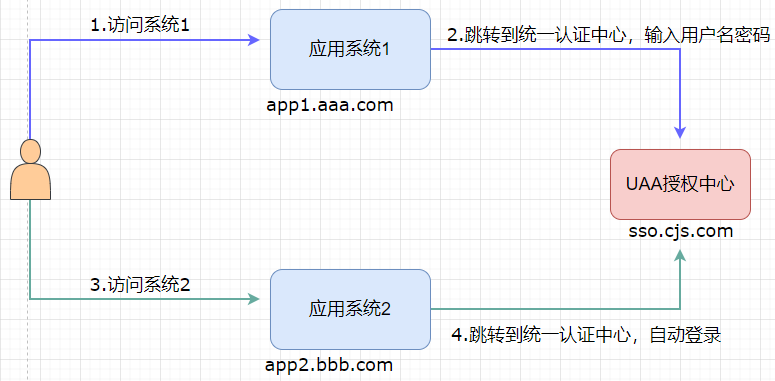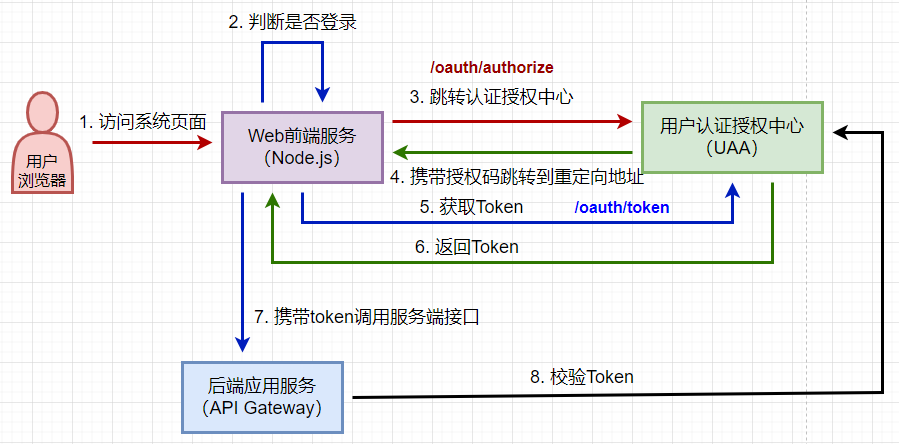1 单点登录
关于单点登录的原理,我觉得下面这位老哥讲的比较清楚,有兴趣可以看一下,下面我把其中的重点在此做个笔记总结
https://juejin.cn/post/6844904079274197005
主流的单点登录都是基于共享cookie 来实现的
1.1 同域单点登录
适用场景:都是企业内部系统,所有系统都适用同一个一级域名,并通过不同的二级域名区分
举个例子:公司有一个一级域名cjs.com,我们有三个系统需要实现单点登录,分别是门户系统(sso.cjs.com)、应用系统1(app1.cjs.com)、应用系统2(app2.cjs.com)

核心原理:
- 门户系统设置 Cookie 的 domain 为一级域名也就是 cjs.com,这样就可以共享门户的 Cookie 给所有的使用该域名(xxx.cjs.com)的系统
- 使用 Spring Session 等技术让所有系统共享 Session
- 所有登录都跳转到门户系统去登录,也就说门户系统有两个页面就够了:登录页(login.html)和首页(index.html)。通过首页链接可以进入到各子业务系统。
- 可以在加一层网关(Spring Cloud Gateway)
1.2 跨域单点登录
由于域名不一样不能共享 Cookie 了,这样就需要通过一个单独的授权服务(UAA)来做统一登录,并基于共享UAA的 Cookie 来实现单点登录。
举个例子:公司接到一个大项目,把其中部分系统外包给第三方来做,或者直接采购第三方服务商的系统,或者是子业务系统1采购服务商A的系统,子系统2采购B服务商的系统。无论什么情况,总之系统集成就需要单点登录。

核心原理:
- 用户访问系统1,如果未登录,则跳转到UAA系统请求授权,并输入用户名/密码完成登录
- 登录成功后UAA系统把登录信息保存到 Session 中,并在浏览器写入域为 sso.com 的 Cookie
- 用户访问系统2,如未登录,则跳转到UAA系统请求授权
- 由于是跳转到UAA系统的域名 sso.com 下,所以能通过浏览器中UAA的 Cookie 读取到 Session 中之前的登录信息完成单点登录
1.3 基于OAuth2的跨域单点登录

1.4 前后端分离的跨域单点登录
前后端分离的核心概念是后端仅返回前端所需的数据,不再渲染HTML页面,前端HTML页面通过AJAX调用后端的RESTFUL API接口并使用JSON数据进行交互
跨域间的前后端分离项目也是基于共享统一授权服务(UAA)的cookie来实现单点登录的,但是与非前后分离不一样的是存在以下问题需要解决
- 没有过滤器/拦截器,需要在前端判断登录状态
- 需要自己实现oauth2的授权码模式交互逻辑
- 需要解决安全性问题,oauth2的clientSecret参数放在前端不安全

补充:前端获取授权码
- redirect_uri写前端地址
- 重定向到前端页面,页面获取到授权码code,拿code换token
示例参考:
http://localhost:9000/callback.html?code=xxx
lang="zh">charset="UTF-8"></span>Title<span style="color: rgba(249, 38, 114, 1)"> type="text/javascript"src="jquery-3.6.0.min.js">